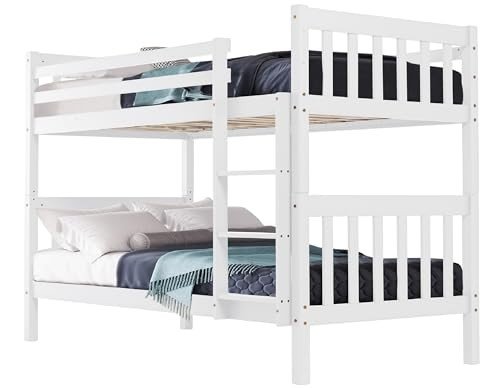The Ultimate Guide to Bunk Beds for Children: Safety, Styles, and Benefits
When it concerns styling a kid's room, parents often face the dual difficulty of taking full advantage of space while ensuring convenience and performance. Bunk beds have emerged as a popular option that attends to these needs, using not simply sleeping arrangements however also contributing to a space's visual. In this extensive guide, we will explore various aspects of children's bunk beds, concentrating on their advantages, security functions, styles, and factors to consider for parents pondering this purchase.
Table of Contents
- Benefits of Bunk Beds
- Safety Features to Consider
- Kinds Of Bunk Beds
- Style and Style Options
- Maintenance Tips
- Regularly Asked Questions (FAQs)
1. Advantages of Bunk Beds
Bunk beds use various benefits for kids and their parents. Here are some essential benefits:
- Space-Efficiency: Bunk beds are an outstanding service for smaller rooms. By stacking Ela Grimes on top of another, more flooring space is readily available for play, storage, or study locations.
- Cost-efficient: When children share spaces, bunk beds can minimize the need for acquiring two separate beds, thus saving money.
- Cultivates Social Interaction: Bunk beds can assist siblings or friends bond by sharing a space, creating opportunities for social development.
- Enjoyable Factor: The concept of sleeping "up high" includes a playful aspect to bedtime, making the transition to sleeping alone easier for some kids.
- Versatile Design: Bunk beds are available in various styles, colors, and designs to match any space style, permitting for customization that shows the kid's character.
2. Security Features to Consider
Safety is vital when it pertains to children's furnishings, especially when it comes to bunk beds. Here are some vital security functions to assess:
| Safety Feature | Description |
|---|---|
| Sturdy Construction | Frames made from solid wood or metal are preferred. |
| Guardrails | Should be at least 5 inches high and extend along both sides of the upper bunk. |
| Ladder Design | Make sure ladders are safely connected and have non-slip actions. |
| Bed mattress Size & & Fit | Need to fit snugly within the frame to avoid gaps. |
| Weight Limit | Always comply with the producer's weight limit recommendations. |
3. Types of Bunk Beds
Bunk beds are available in numerous styles, catering to different needs, choices, and space sizes. Here are some typical types:
- Standard Bunk Bed: The most standard type, with one bed on top of another.
- Loft Bed: Features a high upper bed with space beneath for a desk or play area.
- Futon Bunk Bed: Combines a top bunk with a futon on the bottom, supplying versatility for seating and sleeping.
- L-Shaped Bunk Bed: This style has the top bunk set at a perpendicular angle to the bottom, creating a small corner location.
- Triple Bunk Bed: Accommodates 3 kids using stacked beds, ideal for large families or slumber parties.
4. Style and Style Options
When it comes to choosing a design for kids's bunk beds, the choices are practically unlimited. Here are some popular designs:
- Traditional Style: Often made from wood, these bunk beds include ornate details and are ideal for traditional or rustic-themed rooms.
- Modern Style: Characterized by clean lines and minimalist designs, modern-day bunk beds can be made from metal or wood.
- Themed Bunk Beds: Some brands offer bunk beds formed like castles, cars, or playhouses, making bedtime less of a task.
- Convertible Bunk Beds: These can be separated into 2 private beds, using flexibility as kids grow.
- Colorful Options: Bunk beds in lively colors can include a sense of happiness and playfulness to any room.
5. Upkeep Tips
Maintaining a bunk bed is vital for longevity and safety. Here are some suggestions:
- Regular Inspections: Check for loose screws or bolts every few months and tighten them as needed.
- Cleaning: Wipe down frames routinely to prevent dust build-up; think about using a vacuum for hard-to-reach locations.
- Mattress Care: Rotate bed mattress frequently and utilize protective covers to extend their life.
- View for Wear and Tear: Look for any indications of damage in the wood or metal and consider replacing parts if needed.
- Teach Kids Safety Rules: Encourage children to use ladders properly and ensure they understand the safety features of their bed.
6. Frequently Asked Questions (FAQs)
Q1: What age is suitable for oversleeping a top bunk?
A1: Typically, kids aged 6 and older are recommended for upper bunk sleeping, as they have the needed motor skills to climb securely.
Q2: Do bunk beds come with a mattress?
A2: Most bunk beds are offered as frames only, so you will require to buy bed mattress individually. Ensure that the bed mattress fits the frame comfortably.
Q3: Can bunk beds be separated later on?
A3: Many designs enable conversion into two private beds, offering flexibility for future requirements.
Q4: How can I guarantee my child's safety on a bunk bed?
A4: Comply with security requirements and ensure guardrails, a strong frame, and a protected ladder remain in location.
Q5: Are there weight limitations on bunk beds?
A5: Yes, constantly examine the maker's requirements relating to weight limits to ensure security.
Bunk beds for children can serve numerous purposes while making sure security and style. With diverse designs and designs available on the market, moms and dads can find a system that not only maximizes bed room space but likewise shows their child's distinct tastes. Similar to any furniture, understanding security features, upkeep, and how they suit a child's way of life will make sure that these beds remain a useful furnishings service for many years to come.
Through cautious consideration and adherence to safety guidelines, bunk beds can provide a lasting, enjoyable, and practical sleeping solution that children like.

